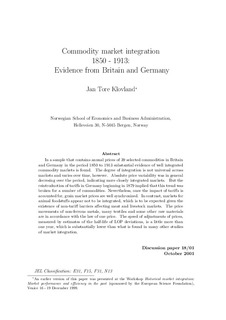Commodity market integration 1850 - 1913 : evidence from Britain and Germany
Working paper
Permanent lenke
http://hdl.handle.net/11250/162828Utgivelsesdato
2001-10Metadata
Vis full innførselSamlinger
- Discussion papers (SAM) [657]
Sammendrag
In a sample that contains annual prices of 39 selected commodities in Britain
and Germany in the period 1850 to 1913 substantial evidence of well integrated
commodity markets is found. The degree of integration is not universal across
markets and varies over time, however. Absolute price variability was in general
decresing over the period, indicating more closely integrated markets. But the
reintroduction of tariffs in Germany beginning in 1879 implied that this trend was
broken for a number of commodities. Nevertheless, once the impact of tariffs is
accounted for, grain market prices are well synchronized. In contrast, markets for
animal foodstuffs appear not to be integrated, which is to be expected given the
existence of non-tariff barriers affecting meat and livestock markets. The price
movements of non-ferrous metals, many textiles and some other raw materials
are in accordance with the law of one price. The speed of adjustments of prices,
measured by estimates of the half-life of LOP deviations, is a little more than
one year, which is substantially lower than what is found in many other studies of market integration.
Utgiver
Norwegian School of Economics and Business Administration. Department of EconomicsSerie
Discussion paper2001:18
